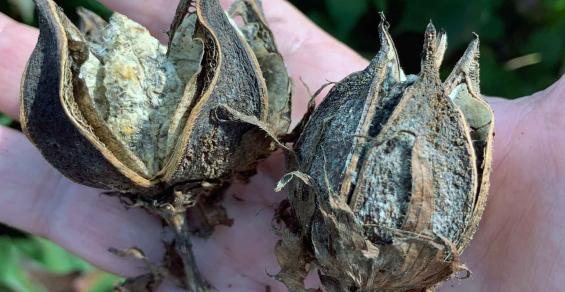We have fungicides labeled on cotton, but they are not effective against boll rot.
Boll rot has been ugly and severe in many Southeastern cotton fields during this season. Growers are understandably frustrated. The sight of boll rot can be sickening. Farmers grew the crop, and the plants put the bolls on. Now, too many are dark and black and rotted rather than white and fluffy.
Farmers, consultants and Extension agents did everything they could to produce stout cotton, but disease took yield away from them. In Georgia, I estimate that losses to boll rot in 2022 will be approximately 10% to 12% across the state. Losses will be much greater than this in some fields.
I’ve had a recurring and disturbing dream lately. It starts off innocent. I stand in front of a large group of cotton farmers at a winter production meeting in early 2023. I say we can expect another “La Ni?a,” which means we will likely have another warmer winter.
I give them researched-based recommendations on management of seedling diseases. Make sure soil temperatures are above 65?F at planting. Consider using additional seed treatments or in-furrow fungicides if at increased risk to seedling disease.
I remind them nematodes must be managed before the furrow is closed. Our management tools include crop rotation, planting a nematode-resistant variety, and judicious use of nematicides.
Diseases
I say we have four important leaf diseases of cotton, to include bacterial blight (plant a resistant variety), Stemphylium leaf spot (focus on potassium), target spot, and areolate mildew (scout your cotton and apply fungicides as needed and before disease gets well-established in the field). I remind growers that by following these steps, they WILL protect significant yield in their cotton crops.
In the dream, I smile with reassurance and confidence and ask for any questions. At that moment in my dream, every cotton farmer in the room raises a hand. Some raise both hands. In the ensuing chaos, plates of ribs, chicken, and catfish bones are knocked off the tables and bowls of banana pudding (the best “baked” kind and not the “made from instant” kind) spill on to the floor.
It’s confusion. I hear repeated shouts.
“Boll rot! Dang it, Bob, you didn’t talk about boll rot! How can we grow cotton when we are losing our bottom crop to boll rot??”
My swagger dissipates. I am left bruised. Humbled.
Though bacterial boll rot is present (and can be effectively controlled by planting resistant varieties), most boll rot in the Southeast is caused by molds. Diplodia, Fusarium, and Colletotrichum are all common fungal boll rots here, though we may see others as well, to include Phytophthora boll rot and a rot caused by Sclerotium rolfsii when plant lodge and come in contact with the soil.
Cotton Fungicides
Over 170 species of fungi have been associated with rotted cotton bolls. Many of these are “opportunistic,” and a problem only when the bolls are damaged, as by insects or when their spores are introduced along cracks in suture lines running along the bolls.
Infection by the most important rot pathogens often occurs through the receptacle at the base of the boll and is most problematic during periods of extended wetness with abundant rainfall and humidity. Although fungicides now available to growers are toxic against some of the important fungal pathogens affecting cotton, fungicides still have not been effective in controlling boll rot because of problems with coverage and frequency of needed applications.
Delivering sufficient fungicide through the canopy AND providing adequate coverage over the entire surface of the bolls have been ineffective to date. We have fungicides labeled on cotton, but they are not effective against boll rot.
Today, yesterday, and for our immediate tomorrows, the only recommendation to reduce loss to boll rot is to protect bolls from damage by insects and to increase airflow, reduce humidity, and reduce wetness periods within the canopy.
Throughout the boll rot of 2022, lyrics from a song of my youth have rattled continuously inside my head. The original lyrics go “One night in Bangkok makes a hard man humble, makes the tough guy tumble.”
I now hear, “One year of boll rot makes Bob Kemerait humble, makes him stumble …” and the season isn’t even over yet.
In our upcoming winter meetings, we will talk about many things. Boll rot will be one of them, though as in my dreams you will be left wishing I had more to offer. But in understanding why boll rot was so severe in 2022, we may be able to take small steps to better protect yield in 2023.




